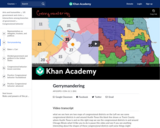
An overview of Generational and lifecycle effects on political ideology.
- Subject:
- Political Science
- Social Science
- Material Type:
- Lesson
- Provider:
- Khan Academy
- Provider Set:
- Khan Academy
- Author:
- Sal Khan
- Date Added:
- 07/16/2021

An overview of Generational and lifecycle effects on political ideology.

The resource is a learning module that contains a three-part curriculum about the social psychology of racial bias and biased policing. It includes several TEDx lecture videos, textbook and primary source article readings, journals and written assignments for reflection, and resources for acting for social justice. It can generate a certificate of completion after the parts are marked as reviewed and reflection papers submitted.
It is currently available in Blackboard and Canvas LMS versions. We are working on a Google Docs version. If you would like to import it and adapt it for another LMS, and want to contribute to this project, please let me know and we'll get you added to the project.
It was inspired by my university releasing the university from work in honor of the George Floyd memorials. I created it as an extra credit opportunity, but could be integrated in the psychology curriculum when teaching about stereotyping, prejudice, and discrimination.
Dana C. Leighton, PhD
Assistant Professor of Psychology, Texas A&M University—Texarkana
Director, Peace and Justice Psychology Lab
903-334-6627 • dleighton@tamut.edu
home: http://danaleighton.net • blog: http://danaleighton.edublogs.org
preferred pronouns: he, him, his

General George Washington held a rally to launch his 2016 campaign to promote participation in the democratic process. Follow along at itstartshere2016.org

George Washington: First in War, First in Peace, and First in the Hearts of His Countrymen consists of three lessons examining George Washington's leadership in the French and Indian War, at the Federal Convention, and as chief executive. They are based on primary source documents from George Washington Papers. The documents from Washington's Letterbooks include focus questions that may be used in Socratic seminars, cooperative learning, individual and group work.

Since 2005, the "Past and Present" podcast from Colonial Williamsburg has taken you behind the scenes to meet interpreters, chefs, tradesmen, musicians, historians, curators, and more. We offer two versions of our podcast: one that's audio-only and one that includes a slideshow. In this episode: A pocket-sized ornament gives monumental insight into the private life of America’s best-known General: George Washington.

Since 2005, the "Past and Present" podcast from Colonial Williamsburg has taken you behind the scenes to meet interpreters, chefs, tradesmen, musicians, historians, curators, and more. We offer two versions of our podcast: one that's audio-only and one that includes a slideshow. In this episode, as Veterans Day approaches, the venerated Virginian veteran himself, Gen. George Washington, discusses his military past and how he believes veterans should be honored today.

One of the most significant documents in Constitutional History, George Washington's Farewell Address, is a letter written by the first American President, George Washington, with the help of Alexander Hamilton, to "The People of the United States." Washington wrote the letter near the end of his second term as President.

In Georgia v. Randolph (2006), the U.S. Supreme Court found that evidence seized during an unwarranted search where two occupants are present but one objects to the search, cannot be used in court against the objecting occupant.

Kibera, a poor community, in Nairobi, was a blank spot on the map until recently. This video from Penn State Public Broadcasting’s Geospatial Revolution shows how geospatial technology enabled residents to map resources to help their community.

Gerrymandering and its history.

Infographic and teachers guide about teaching gerrymandering. Analysis of redistricting and gerrymandering, negative impact of racial gerrymandering.

Primary sources are the raw materials of history — original documents and objects that were created at the time under study. They are different from secondary sources, accounts that retell, analyze, or interpret events, usually at a distance of time or place. This webpage will help educators teach students using primary sources and engage them in analyzes these sources.

To introduce demographic characteristics to students, teachers will help them create a population pyramid. Then, students will use an online tool called QuickFacts to find census data on demographic characteristics for a county in 2022. They will compare it to older data from the same county to find changes and trends over time. They will then use QuickFacts to examine data about their school’s county. Students will use this information to help them understand how business owners and community leaders use data on demographic characteristics to make decisions.

Series A funding from a seed venture capitalist. Created by Sal Khan.

This activity is designed to help students get to know the Representatives serving their district in the U.S. House of Representatives. Students will be tasked with researching and analyzing the political background, voting history, and floor activities of the Representatives serving several local districts.

The Supreme Court determined that the Commerce Clause of the Constitution grants the federal government the power to determine how interstate commerce is conducted. This resource includes teacher materials, guides, and activities for teaching about this Supreme Court case.

The Court unanimously ruled in Gideon’s favor, stating that the Sixth Amendment requires state courts to provide attorneys for criminal defendants facing felony charges who cannot otherwise afford counsel. This resource includes teacher materials, guides, and activities for teaching about this Supreme Court case.

Gilded Age versus Silicon Valley. A discussion with Sal Khan.

Learn how the Gini coefficient can be used to interpret income inequality in this video.

The William A. Gladstone Collection of African American Photographs provides almost 350 images showing African Americans and related military and social history. The Civil War era is the primary time period covered, with scattered examples through 1945. Most of the images are photographs, including 270 cartes de visite. For the list of approximately 100 different photographers, see the Creator/Related Names Index.